Zoom
Trash

Weighted Blankets - Therapeutic Weighted Blanket for Those with Autism. How to Make a Weighted Blanket. Instructions to make a weighted blanket. Instructions to make a weighted blanket Contributed by Minna Mettinen Use two existing blankets to do this.
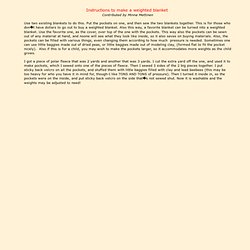
Put the pockets on one, and then sew the two blankets together. This is for those who dont have dollars to go out to buy a weighted blanket. Also this way, a favorite blanket can be turned into a weighted blanket. Use the favorite one, as the cover, over top of the one with the pockets. I got a piece of polar fleece that was 2 yards and another that was 3 yards. Calming the senses with weighted blankets « Craft Nectar. Note from Weeks: Both my husband and daughter are restless sorts.
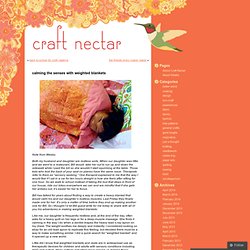
When our daughter was little and we went to a restaurant, Bill would take her out to run up and down the sidewalk while I paid the bill so she wouldn’t start squirming at the table. Those kids who kick the back of your seat on planes have the same issue. Therapists refer to them as “sensory seeking.” One therapist explained to me that the way I would feel if I sat in a car for ten hours straight is how she feels after sitting for one hour.
Bill has talked for years about finding a way to create a heavy blanket that would calm his and our daughter’s restless muscles. Like me, our daughter is frequently restless and, at the end of the day, often asks for a heavy quilt on her legs or for a deep-muscle massage. Little did I know that weighted blankets and vests are in widespread use as therapeutic devices for children and adults with sensory conditions including ADD and autism. Like this: Like Loading... Home page. DreamCatcher Weighted Blankets. 5 Lb Glitter Gel Weighted Lap Pad - National Autism Resources. Climagel Weighted Blanket - Size 3 - 9.9lbs Plain Green: Health & Personal Care. Weighted Blankets,DreamCatcher, Affordable,Cozy, Calm,Magic,Sensacalm.
Weighted magic blanket recommended by OTs for calm and comfort. Weighted Blankets and Lap Pads by Salt of the Earth Weighted Gear. Inflatable Pressure Vest-ensory processing differences-SQUEASE. Squease is an inflatable pressure vest designed for people who have difficulties processing sensory information, like people with autism, ADHD, sleeping or anxiety disorders.
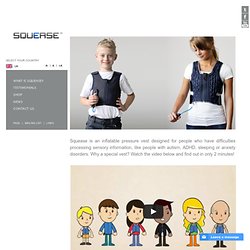
Why a special vest? Watch the video below and find out in only 2 minutes! Squease gives a comfortable hug-like pressure, helping you to cope with stress and sensory overload, avoid tantrums, improve concentration or fall asleep quicker. Kids Vests Our two smallest vests are perfect for children who generally need constant hugs, have difficulties sleeping, calming down or focusing on school tasks. Vests and Hooded Tops Our larger vests can be hidden in one of our hooded tops. Rent a Pressure Vest Not sure if the pressure vest will work for you?
Squease Stories. How To Make A Weighted Vest. Therapists and people with autism use weighted vest to help keep themselves or their clients focused on the task at hand.
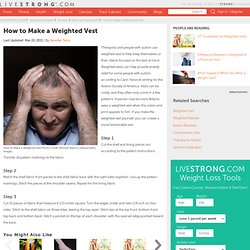
Weighted vests can help provide anxiety relief for some people with autism, according to Carin Yavorcik writing for the Autism Society of America. Vests can be costly, and they often only come in a few patterns. A person may be more likely to wear a weighted vest when the colors and print appeals to him. If you make the weighted vest yourself, you can create a more fashionable vest. Cut the shell and lining pieces out according to the pattern instructions. Match the shell fabric front panels to the shell fabric back with the right sides together. Cut 10 pieces of fabric that measure 4 1/2 inches square. Pin the lining and shell, right sides together. Turn the vest right side out. Open the vest to expose the lining side. Cut twenty 4-by-4-inch squares of fabric. Remove the vest every 20 minutes to check for pressure points, indicated by reddening of the skin. Weighted Vest for Children, Teens and Adults with Autism Aspergers.
DeLana Honaker, PhD, OTR Occupational Therapy Blog: The Evidence on Weighted Vests. The Evidence on Weighted Vests Many kids with identified (and non-identified) special needs such as autism spectrum disorders, sensory processing disorders, ADD/ADHD, developmental delays demonstrate difficulties with initial and sustained attention to task, focus, self-stimulating behaviors, self-abusive behaviors and tactile and sensory defensiveness.
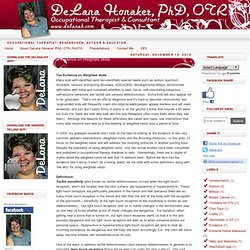
Some kids will also appear not to be ‘grounded’. That’s not an official diagnosis and it’s hard to describe conclusively, but ‘ungrounded’ kids will frequently crash into objects/walls/people, appear restless and will roam aimlessly, and just don’t seem firmly in place or on the ground (I know that sounds a bit weird but trust me, there are kids who look like this and therapists often know them when they see them). Although the reasons for these difficulties are varied and many, one intervention that many kids respond very well to is the wearing of weighted vests over a period of time. Definitions: The Evidence: Who: The Intervention: 08-48-R1-online-first.pdf (application/pdf Object)